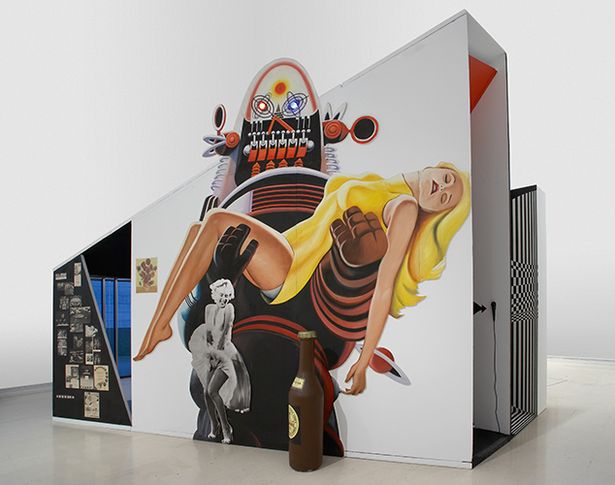
We’ve already heard about Marilyn’s Scottish ancestry (see here), but as Craig Williams reports for Glasgow Live, local art pioneer John McHale was inspired by Marilyn – while his London-based colleague Richard Hamilton featured her iconic pose from The Seven Year Itch in an early installation, as shown above – long before Andy Warhol made her his muse.
“The Maryhill area of Glasgow can lay claim to a few things of note … But few would ever imagine that it could hold claim to a title many might believe is held by New York – that of being the birthplace of Pop Art. It wasn’t Warhol who could be considered as the true ‘forefather’ of Pop Art, nor indeed did he coin the ubiquitous term we all know today thanks (in the most part) to his work. That belongs to the almost forgotten Scottish artist, art theorist, sociologist and future studies searcher John McHale – a man born and bred in Maryhill.
McHale coined the term ‘Pop Art’ back in 1954 to describe the aesthetic expressed in art in response to the commercialization of Western culture … Yet it was to be the groundbreaking and hugely popular This Is Tomorrow exhibition at Whitechapel Gallery in London in 1956 that would light the Pop Art touchpaper. The exhibition – which McHale played a central part in – was described by esteemed art critic Reyner Banham as being the ‘first Pop Art manifestation to be seen in any art gallery in the world’. McHale, alongside Richard Hamilton and John Voelcker, presented images from popular culture from magazines, film publicity posters and comics as part of the exhibition.
And as part of the exhibition, McHale was able to provide plenty of the material, having returned from a scholarship at Yale University with a black metal trunk full to the brim with magazine clippings … Yet it wasn’t until 1962 when Pop Art was effectively ‘rubber-stamped’ in the America psyche via the “Symposium on Pop Art” at the Museum of Modern Art in New York – the same year that a certain Andy Warhol held his first ever solo exhibition in the city … Warhol’s exhibit featured some of his most well-known works, including ‘Marilyn Diptych’ … which repeated Marilyn Monroe’s image to evoke her ubiquitous presence in the media – it’s very possible that Warhol was inspired to produce the work by none other than Maryhill’s own McHale.
That’s because, in a collection of writings concerning popular imagery and fine art called ‘The Expendable Icon’ published in Architectural Design magazine in 1959, McHale referenced Marilyn Monroe in a section entitled ‘The Girl With The Most’. Monroe, who McHale regarded as ‘doubly interesting’ featured among many popular ‘ikons’ he identified alongside Elvis Presley – another of Warhol’s subjects. McHale wrote that the film star was ‘held up as an example of someone not only defined by personal iconography, but whose image is saturated in the media to such an extent that she serves as a model for universal imitation’.
1962 would see McHale emigrate to live in the US for definite … John McHale (Jr.) notes the difference between his father’s work and that of Warhol. Where Warhol was focused on being a celebrity artist, McHale’s agenda was to extend the boundaries of art to the masses according to his son … Incredibly, his father was also asked to explain his Pop Art ideas by Time magazine and be featured on the cover, but ‘regrettably refused for personal family reasons … From my discussions with my father it was apparent that he originally conceived of Pop Art as being more than just some glib advertising and reflection of popular culture … This may not seem radical in the present century, but half a century ago these were fighting words and cutting edge concepts. Pop Art was about opening up aesthetic possibilities and making art freely available to all …'”